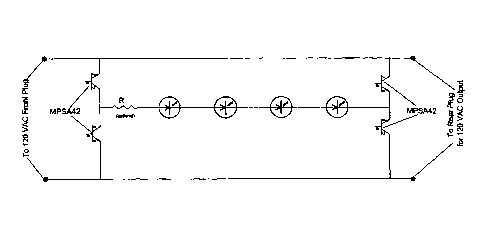Une partie des informations de ce site Web a été fournie par des sources externes. Le gouvernement du Canada n'assume aucune responsabilité concernant la précision, l'actualité ou la fiabilité des informations fournies par les sources externes. Les utilisateurs qui désirent employer cette information devraient consulter directement la source des informations. Le contenu fourni par les sources externes n'est pas assujetti aux exigences sur les langues officielles, la protection des renseignements personnels et l'accessibilité.
L'apparition de différences dans le texte et l'image des Revendications et de l'Abrégé dépend du moment auquel le document est publié. Les textes des Revendications et de l'Abrégé sont affichés :
| (12) Demande de brevet: | (11) CA 2840699 |
|---|---|
| (54) Titre français: | GUIRLANDE LUMINEUSE A DEL A FAIBLE SCINTILLATION ET DOUBLE ALTERNANCE |
| (54) Titre anglais: | FULL WAVE LOW FLICKER LED LIGHT STRING |
| Statut: | Réputée abandonnée et au-delà du délai pour le rétablissement - en attente de la réponse à l’avis de communication rejetée |
| (51) Classification internationale des brevets (CIB): |
|
|---|---|
| (72) Inventeurs : |
|
| (73) Titulaires : |
|
| (71) Demandeurs : |
|
| (74) Agent: | SMART & BIGGAR LP |
| (74) Co-agent: | |
| (45) Délivré: | |
| (22) Date de dépôt: | 2014-01-24 |
| (41) Mise à la disponibilité du public: | 2015-02-08 |
| Licence disponible: | S.O. |
| Cédé au domaine public: | S.O. |
| (25) Langue des documents déposés: | Anglais |
| Traité de coopération en matière de brevets (PCT): | Non |
|---|
| (30) Données de priorité de la demande: | |||||||||
|---|---|---|---|---|---|---|---|---|---|
|
A split bridge circuit for rectifying the alternating current house supply
into direct current (D.C.), using bi-polar transistor as rectifying
devices. Using
the collector and emitter terminals of bi-polar
transistors results in a high forward voltage drop across the
transistors (particularly as compared to the voltage drop across diode
rectifiers in the prior art circuits), which reduces ripple significantly
and lessens, or even eliminates, the need for a series limiting resistor
in the circuit.
Note : Les revendications sont présentées dans la langue officielle dans laquelle elles ont été soumises.
Note : Les descriptions sont présentées dans la langue officielle dans laquelle elles ont été soumises.

2024-08-01 : Dans le cadre de la transition vers les Brevets de nouvelle génération (BNG), la base de données sur les brevets canadiens (BDBC) contient désormais un Historique d'événement plus détaillé, qui reproduit le Journal des événements de notre nouvelle solution interne.
Veuillez noter que les événements débutant par « Inactive : » se réfèrent à des événements qui ne sont plus utilisés dans notre nouvelle solution interne.
Pour une meilleure compréhension de l'état de la demande ou brevet qui figure sur cette page, la rubrique Mise en garde , et les descriptions de Brevet , Historique d'événement , Taxes périodiques et Historique des paiements devraient être consultées.
| Description | Date |
|---|---|
| Inactive : CIB expirée | 2020-01-01 |
| Inactive : CIB attribuée | 2019-10-15 |
| Inactive : CIB attribuée | 2019-10-15 |
| Demande non rétablie avant l'échéance | 2019-01-24 |
| Le délai pour l'annulation est expiré | 2019-01-24 |
| Réputée abandonnée - omission de répondre à un avis sur les taxes pour le maintien en état | 2018-01-24 |
| Requête pour le changement d'adresse ou de mode de correspondance reçue | 2018-01-12 |
| Inactive : CIB expirée | 2016-01-01 |
| Inactive : CIB enlevée | 2015-12-31 |
| Inactive : Page couverture publiée | 2015-02-16 |
| Demande publiée (accessible au public) | 2015-02-08 |
| Inactive : CIB expirée | 2015-01-01 |
| Inactive : CIB enlevée | 2014-12-31 |
| Inactive : Certificat dépôt - Aucune RE (bilingue) | 2014-03-24 |
| Inactive : CIB attribuée | 2014-03-06 |
| Inactive : CIB attribuée | 2014-03-06 |
| Inactive : CIB attribuée | 2014-02-13 |
| Inactive : CIB en 1re position | 2014-02-13 |
| Inactive : Certificat dépôt - Aucune RE (bilingue) | 2014-02-05 |
| Exigences de dépôt - jugé conforme | 2014-02-05 |
| Demande reçue - nationale ordinaire | 2014-02-04 |
| Déclaration du statut de petite entité jugée conforme | 2014-01-24 |
| Inactive : Pré-classement | 2014-01-24 |
| Date d'abandonnement | Raison | Date de rétablissement |
|---|---|---|
| 2018-01-24 |
Le dernier paiement a été reçu le 2016-08-10
Avis : Si le paiement en totalité n'a pas été reçu au plus tard à la date indiquée, une taxe supplémentaire peut être imposée, soit une des taxes suivantes :
Veuillez vous référer à la page web des taxes sur les brevets de l'OPIC pour voir tous les montants actuels des taxes.
| Type de taxes | Anniversaire | Échéance | Date payée |
|---|---|---|---|
| Taxe pour le dépôt - petite | 2014-01-24 | ||
| TM (demande, 2e anniv.) - petite | 02 | 2016-01-25 | 2015-08-04 |
| TM (demande, 3e anniv.) - petite | 03 | 2017-01-24 | 2016-08-10 |
Les titulaires actuels et antérieures au dossier sont affichés en ordre alphabétique.
| Titulaires actuels au dossier |
|---|
| INC. JLJ |
| Titulaires antérieures au dossier |
|---|
| JOHN L. JANNING |